Textile printing method and apparatus applying inkjet printer
a printing method and inkjet printer technology, applied in printing, other printing apparatus, dyeing process, etc., can solve the problems of high cost of padding method, and inability to meet continuous batch process requirements
- Summary
- Abstract
- Description
- Claims
- Application Information
AI Technical Summary
Benefits of technology
Problems solved by technology
Method used
Image
Examples
example 1
Manufacture of a Pretreatment Liquid
[0073]1) Manufacture of Pretreatment Mixed Liquid 1
Glycerin5%Carboxyl methyl cellulose1.5% Urea5%Triton X-1005%(brand name: manufactured by Union Carbide)Sodium bicarbonate5%Purified waterthe rest amount
[0074]The said respective substances were put into a suitable container, and then it was sufficiently agitated by using an agitator. Then, the agitated mixed liquid was let to pass through a membrane filter (manufactured by MFS, using cellulose acetate or nitrocellulose as a membrane material). Thereby, a pretreatment liquid for a reactive dye ink was manufactured.
[0075]2) Manufacture of Pretreatment Mixed Liquid 2 (Silk: Satin)
Glycerin 5%Hydroxyl ethyl cellulose2.5%Urea 5%Triton X-1000.5%(brand name: manufactured by Union Carbide)Ammonium tartrate2.5%Purified waterthe rest amount
[0076]By agitating the above substances and letting the agitated mixed liquid pass through a filter in the same method as in the above 1), a pretreatment liquid for an aci...
example 2
Pretreatment Using the Pretreatment Liquid of Example 1 and Inkjet Printing
[0079]Each pretreatment liquid container of the pretreating apparatus, in which the F055030 head (brand name: manufactured by Epson) was installed, was filled with each pretreatment liquid manufactured in Example 1, and each fabric of cotton (40 counts, plain weave), silk (satin) and polyester (charmeuse) was pretreated by applying each suitable pretreatment liquid to each fabric through the pretreatment head controlled by the control unit depending upon the kind of each fabric. Each pretreated fabric was printed in each ink suitable for each material, that is to say, cotton was printed in Cibacron MI (manufactured by Ciba-Geigy), the reactive ink, silk was printed in LANASET SI (manufactured by Ciba-Geigy), and polyester was printed in TERASIL DI (manufactured by Ciba-Geigy). After printing each fabric, cotton (40 counts, plain weave) was maintained at 102° C. for 12 minutes in a steamer (steaming device) to...
example 3
Manufacture of Individual Component Compositions of a Pretreatment Liquid
[0080]1) Manufacture of a Sizing Agent Composition (A)
Hydroxyl ethyl cellulose5%Glycerin2%FLUORAD FC1700.3% Purified waterthe rest amount
[0081]The said respective substances were put into a suitable container, and then it was sufficiently agitated by using an agitator. Then, the agitated mixed liquid was let to pass through a membrane filter (manufactured by MFS, using cellulose acetate or nitrocellulose as a membrane material). Thereby, a sizing agent composition (A) was manufactured.
[0082]2) Manufacture of a Humectant Composition (B)
Urea5%Glycerin2%FLUORAD FC1700.3% Purified waterthe rest amount
[0083]By agitating the above substances and letting the agitated mixed liquid pass through a filter in the same method as in the above 1) of Example 3, a humectant composition (B) was manufactured.
[0084]3) Manufacture of a pH Control Agent Composition (C) for the Reactive Dye Ink
Sodium bicarbonate5%Glycerin2%FLUORAD FC...
PUM
| Property | Measurement | Unit |
|---|---|---|
| viscosity | aaaaa | aaaaa |
| viscosity | aaaaa | aaaaa |
| energy | aaaaa | aaaaa |
Abstract
Description
Claims
Application Information
 Login to View More
Login to View More - R&D
- Intellectual Property
- Life Sciences
- Materials
- Tech Scout
- Unparalleled Data Quality
- Higher Quality Content
- 60% Fewer Hallucinations
Browse by: Latest US Patents, China's latest patents, Technical Efficacy Thesaurus, Application Domain, Technology Topic, Popular Technical Reports.
© 2025 PatSnap. All rights reserved.Legal|Privacy policy|Modern Slavery Act Transparency Statement|Sitemap|About US| Contact US: help@patsnap.com



